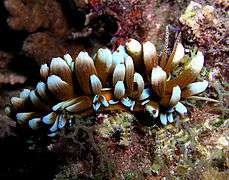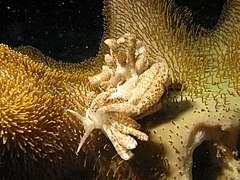Phyllodesmium
Phyllodesmium is a genus of predatory sea slugs, aeolid nudibranchs, marine gastropod molluscs in the family Facelinidae.[2]
| Phyllodesmium | |
|---|---|
 | |
| A live individual of Phyllodesmium briareum, head end towards the front | |
| Scientific classification | |
| Kingdom: | |
| Phylum: | |
| Class: | |
| (unranked): | clade Heterobranchia clade Euthyneura clade Nudipleura clade Nudibranchia clade Dexiarchia clade Cladobranchia clade Aeolidida |
| Superfamily: | |
| Family: | |
| Subfamily: | |
| Genus: | Phyllodesmium acantochinum |
| Type species | |
| Phyllodesmium hyalinum Ehrenberg, 1831 | |
| Diversity | |
| 27 species (in this list) | |
| Synonyms | |
| |
These nudibranchs occur in the tropical Indo-Pacific Ocean and warm temperate waters of Japan, Tasmania and South Africa.
The nudibranchs in this genus often show extraordinary mimicry, each species very closely resembling its prey species, which are octocorals, a kind of soft coral.[3]
Some of the species are also unusual in that they are able to utilize zooxanthellae from their prey, in a symbiotic relationship that provides them with extra nutrition from photosynthesis, hence they are commonly called "solar-powered" sea slugs (also see the Sacoglossa).[4]
Species
Species within the genus Phyllodesmium include:
- Phyllodesmium acanthorhinum Moore & Gosliner, 2015
- Phyllodesmium briareum (Bergh, 1896)
- Phyllodesmium colemani Rudman, 1991[5]
- Phyllodesmium crypticum Rudman, 1981[6]
- Phyllodesmium guamense Avila, Ballesteros, Slattery, Starmer & Paul, 1998[7]
- Phyllodesmium horridum (Macnae, 1954)
- Phyllodesmium hyalinum (Ehrenberg, 1831) - type species[8]
- Phyllodesmium iriomotense Baba, 1991[9]
- Phyllodesmium jakobsenae Burghardt & Wägele, 2004[8]
- Phyllodesmium kabiranum Baba, 1991[9]
- Phyllodesmium karenae Moore & Gosliner, 2009[3]
- Phyllodesmium koehleri Burghardt, Schrödl & Wägele, 2008[10]
- Phyllodesmium lembehense Burghardt, Schrödl & Wägele, 2008[10]
- Phyllodesmium lizardense Burghardt, Schrödl & Wägele, 2008[10]
- Phyllodesmium longicirrum (Bergh, 1905)
- Phyllodesmium macphersonae (Burn, 1962)
- Phyllodesmium magnum Rudman, 1991[5]
- Phyllodesmium opalescens Rudman, 1991[5]
- Phyllodesmium orientale Baba, 1991[9]
- Phyllodesmium parangatum Ortiz & Gosliner, 2003[11]
- Phyllodesmium pecten Rudman, 1981[6]
- Phyllodesmium pinnatum Moore & Gosliner, 2009[3]
- Phyllodesmium poindimiei (Risbec, 1928)
- Phyllodesmium rudmani Burghardt & Gosliner, 2006[12]
- Phyllodesmium serratum (Baba, 1949)
- Phyllodesmium tuberculatum Moore & Gosliner, 2009[3]
- Phyllodesmium undulatum Moore & Gosliner, 2014
- Species brought into synonymy
- Phyllodesmium xeniae Gohar & Aboul-Ela, 1957: synonym of Phyllodesmium hyalinum Ehrenberg, 1831
Ecology

Species of the genus Phyllodesmium are carnivorous and feed on octocorals[5] (for example in the family Xeniidae[10]). This is a unique feature within the Aeolidida.[5]
Some of these nudibranchs contain endosymbiotic zooxanthellae, which are in effect single-celled plants.[5] Zooxanthellae are one kind of dinoflagellate protists and they live only within other organisms, most notably in corals. The nudibranchs in this genus obtain zooxanthellae from their food, the soft corals.[6][5] As they previously did within the corals, the zooxanthellae provide the nudibranch with a supply of food in the form of the products of photosynthesis. The nudibranchs are able to avoid digesting these protists, and sequester them in their tissues instead. This process is somewhat reminiscent of the relationship between the Sacoglossan sea slugs and the living chloroplasts that they are able to sequester. Both these nudibranchs and the sacoglossans have been referred to as "solar-powered sea slugs".[4][10]
Many other species of nudibranchs are brilliantly colored in order to warn away would-be predators, that is, they have aposematic coloring. This is because they contain in their tissues many examples of an organ called the cnidosac[13] which contains undischarged cnidocytes (also known as nematocysts). These are stinging cells that the nudibranchs obtain from the tissues of the cnidarians they eat. Thus the very brightly colored nudibranchs are quite unpalatable for predators. Some nudibranchs, such as Glaucus atlanticus, are even capable of stinging humans very painfully.
The nudibranchs in this genus, however, use an opposite tactic. They do not have cnidosacs, and thus they would in reality be palatable to eat for various predators, however they are almost all extremely well camouflaged, so that they resemble almost perfectly the soft coral on which they live and feed, not only in color but also in form. The shape and form of the cerata of the nudibranch in each individual species resembles very closely the tentacles of the species of soft coral polyp on which that species feeds. This excellent camouflage also makes these nudibranchs difficult for humans to notice, and it is likely that a number of species in this genus have not yet been discovered, described and named scientifically.
Another tactic these nudibranchs use to protect themselves is that when threatened by a predator, they can drop one or more of their cerata. These organs will wiggle for some time after being cast off, hopefully distracting a predator away from the animal itself.[14] This is an example of a defensive technique known as autotomy.
A molecular phylogeny study of Phyllodesmium by Moore and Gosliner (2011)[15] demonstrated that the non-symbiotic species of Phyllodesmium evolved separately from the symbiotic species of Phyllodesmium.[15] However, there is one exception: Phyllodesmium karenae evolved in the symbiotic clade and subsequently lost its zooxanthellae.[15]
References
- Ehrenberg C. G. (1831). Sym. Phys., Moll., sign. h. (plates are from 1828.)
- Bouchet, P. (2012). Phyllodesmium Ehrenberg, 1831. Accessed through: World Register of Marine Species at http://www.marinespecies.org/aphia.php?p=taxdetails&id=204424 on 2012-06-05
- Moore E. & Gosliner T. (18 August 2009). "Three new species of Phyllodesmium Ehrenberg (Gastropoda: Nudibranchia: Aeolidoidea), and a revised phylogenetic analysis". Zootaxa 2201: 30–48.
- Rudman, W.B., 1998 (October 11) Solar-powered sea slugs. [In] Sea Slug Forum. Australian Museum, Sydney.
- Rudman W. B. (1991). "Further studies on the taxonomy and biology of the octocoral-feeding genus Phyllodesmium Ehrenberg, 1831 (Nudibranchia: Aeolidacea)". Journal of Molluscan Studies 57(2): 167–203. abstract.
- Rudman W. B. (1981). "The anatomy and biology of alcyonarian-feeding aeolid opistobranch molluscs and their development of symbiosis with zooxanthellae". Zoological Journal of the Linnean Society 72(3): 219-262. doi:10.1111/j.1096-3642.1981.tb01571.x.
- Avila C., Ballesteros M., Slattery M., Starmer J. & Paul V. J. (1998). "Phyllodesmium guamensis (Nudibranchia: Aeolidoidea), a new species from Guam (Micronesia)". Journal of Molluscan Studies 64: 147–160. abstract.
- Burghardt I. & Wägele H. (2004). "A new solar powered species of the genus Phyllodesmium Ehrenberg, 1831 (Mollusca: Nudibranchia: Aeolidoidea) from Indonesia with analysis of its photosynthetic activity and notes on biology". Zootaxa 596: 1-18. PDFt.
- Baba K. (1991). "Taxonomical study of some species of the genus Phyllodesmium from Cape Muroto-misaki, Shikoku, and Okinawa Province, Southern Japan (Nudibranchia: Facelinidae)". Venus 50(2): 109-124. abstract.
- Burghardt I., Schrödl M. & Wägele H. (2008). "Three new solar-powered species of the genus Phyllodesmium Ehrenberg, 1831 (Mollusca: Nudibranchia: Aeolidioidea) from the tropical Indo-Pacific, with analysis of their photosynthetic activity and notes on biology". Journal of Molluscan Studies 74(3): 277-292. doi:10.1093/mollus/eyn016, abstract.
- Ortiz D. M. & Gosliner T. M. (31 July 2003). "A New Species of Phyllodesmium Ehrenberg, 1831 (Mollusca, Nudibranchia) from the Tropical Indo-Pacific". Proceedings of the California Academy of Sciences 54(9): 161–168, 5 figs.
- Burghardt I. & Gosliner T. M. (2006). "Phyllodesmium rudmani (Mollusca: Nudibranchia: Aeolidoidea), a new solar powered species from the Indo-West Pacific with data on its symbiosis with zooxanthellae". Zootaxa 1308: 31-47. abstract. full PDF. (subscription required)
- Aeolid cnidosac Archived 2009-11-09 at the Wayback Machine. Sea Slug Forum, accessed 26 September 2009.
- Phyllodesmium magnum Rudman, 1991 Archived 2012-03-13 at the Wayback Machine. Sea Slug Forum, accessed 26 September 2009.
- Moore E. J. & Gosliner T. M. (2011). "Molecular phylogeny and evolution of symbiosis in a clade of Indopacific nudibranchs". Molecular Phylogenetics and Evolution Volume 58, Issue 1, January 2011, Pages 116–123 doi:10.1016/j.ympev.2010.11.008. accessed 17 December 2010.
External links



